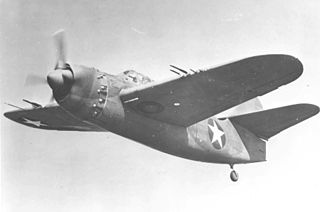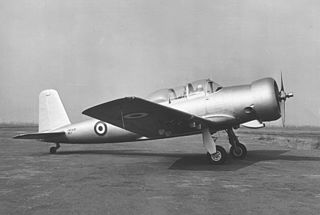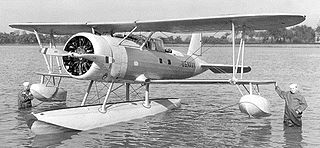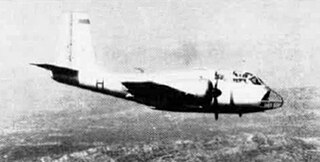
The Lockheed Vega is an American six-passenger high-wing monoplane airliner built by the Lockheed Corporation starting in 1927. It became famous for its use by a number of record-breaking pilots who were attracted to the rugged and very long-range design. Amelia Earhart became the first woman to fly solo across the Atlantic Ocean in one, and Wiley Post used his to prove the existence of the jet stream after having flown around the world twice.

The Bloch MB.160 was a fourteen-seat French airliner intended for use in the French African colonies. Three were built and two entered service with Régie Air-Afrique at the start of World War II. Developments included the Bloch MB.162 bomber which was too late for service and the Sud-Est SE.161 Languedoc, one hundred of which were built post-war.

The Douglas Dolphin is an American amphibious flying boat. While only 58 were built, they served a wide variety of roles including private air yacht, airliner, military transport, and search and rescue.

The P-1 Hawk was a 1920s open-cockpit biplane fighter aircraft of the United States Army Air Corps. An earlier variant of the same aircraft had been designated PW-8 prior to 1925.

The Berliner-Joyce XFJ was a United States prototype biplane fighter aircraft that first flew in May 1930. Designed by Berliner-Joyce Aircraft for the United States Navy, its lower wing, placed below the fuselage and just two feet above the ground, apparently gave it a tendency to ground loop when landing, and it was never ordered for production.

The Boeing F2B was a biplane fighter aircraft of the United States Navy in the 1920s, familiar to aviation enthusiasts of the era as the craft of the Three Sea Hawks aerobatic flying team, famous for its tied-together formation flying.

The Curtiss F6C Hawk was a late 1920s American naval biplane fighter aircraft. It was part of the long line of Curtiss Hawk airplanes built by the Curtiss Aeroplane and Motor Company for the American military.

The Curtiss F7C Seahawk was a carrier-capable biplane fighter aircraft of the United States Navy Marine Corps in the late 1920s and early 1930s.

The Lockheed Altair was a single-engined sport aircraft produced by Lockheed Aircraft Limited in the 1930s. It was a development of the Lockheed Sirius with a retractable undercarriage, and was the first Lockheed aircraft and one of the first aircraft designs with a fully retractable undercarriage.

The XP-13 Viper was a prototype biplane fighter aircraft designed by the American company Thomas-Morse Aircraft Corporation. The airplane was delivered to the United States Army in 1929, but they did not adopt it.

The Vought O2U Corsair was a 1920s biplane scout and observation aircraft. Developed by Vought Corporation, the O2U was ordered by the United States Navy (USN) in 1927. Powered by a 400 hp (298 kW) Pratt & Whitney R-1340 engine, it incorporated a steel-tube fuselage structure and a wood wing structure with fabric covering. Many were seaplanes or amphibians.

The Boeing P-29 and XF7B-1 were an attempt to produce a more advanced version of the highly successful P-26. Although slight gains were made in performance, the U.S. Army Air Corps and U.S. Navy did not order the aircraft.

The Brewster XA-32 was an American attack aircraft, a mid-wing type with an internal bomb bay. The prototype had the R-2800 engine, but it could take the intended R-4360 powerplant. After a dismal set of test results, the XA-32 did not enter production.

The Loening OL, also known as the Loening Amphibian, was an American two-seat amphibious biplane designed by Grover Loening and built by Loening for the United States Army Air Corps and the United States Navy.

The Fiat G.49 was an Italian two-seat basic trainer designed by Giuseppe Gabrielli and built by Fiat.

The Boeing AT-15 was an American twin-engined bomber crew trainer designed and built by Boeing's Wichita Division. Only two prototypes, designated XAT-15, were built. Plans to build over 1,000 were cancelled on the United States' entry into the Second World War.

The Macchi MB.323 was an Italian single-engine basic training monoplane designed and built by Macchi. No orders were placed and only a prototype was built.

The Douglas XO2D-1 was a prototype American observation floatplane of the 1930s. It was a single engined biplane intended to be launched by aircraft catapult from ships of the United States Navy, but only one was built, the production contract going to Curtiss for the SOC Seagull.

The twin turboprop Sud Aviation SE-116 Voltigeur of the late 1950s was a French army support aircraft capable of observation and ground attack operations. Three were built but no series production was undertaken.
The Vought V-326 was an American experimental aircraft used by Pratt & Whitney as a high altitude engine test bed.



















